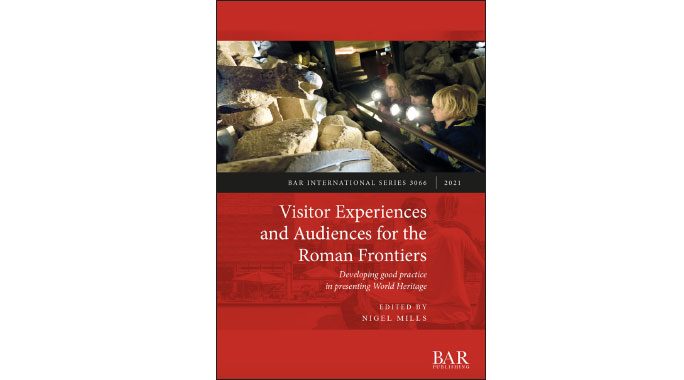Frontier zones are dynamic places, where identities are created and contested, and worldviews and material culture exchanged. The frontiers of the Roman Empire accordingly offer a fascinating lens through which to explore not only the intersections of liminal political and cultural spheres, but for challenging fundamental dichotomies such as ‘Roman/native’ and ‘military/civilian’. Such issues are not only of historical relevance but retain an intense significance for modern communities and the formation of local, national, and international identities. This edited volume, based upon a selection of papers presented at the 2018 Limes Congress held at Viminacium in Serbia, considers museum and heritage site interpretation and community collaboration across the supra-national ‘Frontiers of the Roman Empire World Heritage Site’ (FREWHS). Its 15 papers reflect the work of 19 different authors across five countries (England, Scotland, the Netherlands, Serbia, and Germany), with the editor Nigel Mills a particularly prominent voice, contributing the introduction, one sole-authored chapter, and contributions to a further two chapters.
The volume is a spiritual successor to Mills’ 2013 edited volume ‘Presenting the Romans: Interpreting the Frontiers of the Roman Empire World Heritage Site’, published following the creation of the Hadrian’s Wall Interpretation Framework. This new volume features some of the same authors and explores similar themes nearly a decade later. In his introduction, Mills provides a useful overview of the Framework and his ambition that it should facilitate strategic cohesion between sites while enabling each to focus on their individual narrative strengths. A number of themes can be seen to thread their way through the various contributions, including the value of interpretation strategies for connecting sites and museums (Mills; Hazenberg and Visser; Flügel), public perceptions of the Roman past (Hingley; Griffiths; Burandt; Flügel), the importance of visitor and community engagement (Pieren et al.; Roberts; Golubović; Booth and Nixon; Collins and Shaw), authenticity in interpretation and re-enactment (Burandt; Bishop and Mills), and the creative potential of technology (Weekes and Dobat; Pieren et al.; Flügel). The volume can therefore be seen to valuably engage with a range of fundamental issues which are of intense relevance not only for Roman frontier studies, but for Roman and multi-period archaeologies more broadly. The chapters combine to provide a careful and useful balance between strategic and theoretical insights and case studies of practical project management, audience evaluation, and interpretative techniques.
This is a volume fundamentally about connectivity: between the past and the present; between the different countries that comprise the FREWHS; between the organisations, sites and museums managing the heritage of those frontiers; between sites and their local and visitor communities; and more fundamentally between archaeological interpretative processes and wider public audiences. The importance, and indeed pitfalls, of engaging with specific local and visitor communities are valuably and frankly discussed in the contributions by Hazenberg and Visser, Graafstal, Golubović, and Collins and Shaw. Graafstal encapsulates the inclusive tone of many of the chapters, and the importance of promoting communal cultural ‘ownership’ of heritage, when he writes of the power of connecting ‘the Roman and modern worlds by making the Roman world part of the everyday life of a busy, modern, urban community’ (p.59). Considering that engagement with non-specialist communities forms such an important aspect of the volume’s message, however, it is a little disappointing that an open access version is not available.
The organisational structure of the chapters might also have been approached differently. The contributions by Hingley (Chapter 9), Burandt (Chapter 11), and Collins and Shaw (Chapter 15), for example, provide thought-provoking overarching commentary on the nature of public engagement with archaeological heritage, but are found towards the end of the volume. They might have been more valuably positioned at the start to underpin the case studies and discussions presented by other authors. Some chapters consider related frontiers or projects, such as those by Hazenberg and Visser (Chapter 3), Graafstal (Chapter 5) and Pieren et al. (Chapter 6) which focus on the Dutch limes. However, they are divided by Roberts’ (Chapter 4) engaging discussion of the visitor-led redevelopment of Birdoswald on Hadrian’s Wall. Three chapters, Griffiths (Chapter 12), Booth and Nixon (Chapter 13) and Bishop and Mills (Chapter 14), discuss the 2017 ‘Hadrian’s Cavalry’ dispersed exhibition and its associated events on Hadrian’s Wall, and while they occur sequentially, there is some repetition in their content which could have been avoided. A more formal division of the volume into sections, each perhaps accompanied by editorial commentary, might have been valuable in assisting the reader to engage more easily with the different authors’ complementary discussions.
The minor critical suggestions made above do not, however, detract from either the quality of the individual contributions or their combined value. The chapters are without exception engagingly written, and the diversity of case studies across different frontiers and national heritage contexts is a great strength of the work. The volume is also well illustrated, with most chapters featuring a range of supporting tables and images, many of which are in colour. However, the positioning of these in blocks at the end of their respective chapters serves to somewhat detach them from their discussions in the text. Though this volume focusses on projects related to the management and interpretation of sites comprising the FREWHS, its value is much broader. The chapters combine to support a model, underpinned by the vision of Mills’ Interpretation Framework, which champions open, reflexive, and strategic interpretation, grounded in collaboration between museums, heritage sites, academics, non-heritage stakeholders, and communities. This volume will therefore surely provide thought-provoking reading for any individuals and organisations involved in the care and presentation of Roman archaeology.
Antony Lee
Scottish History and Archaeology Department
National Museums Scotland, United Kingdom
